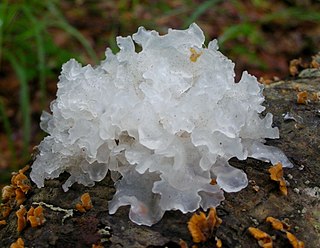
Tremella fuciformis is a species of fungus; it produces white, frond-like, gelatinous basidiocarps. It is widespread, especially in the tropics, where it can be found on the dead branches of broadleaf trees. This fungus is commercially cultivated and is one of the most popular fungi in the cuisine and medicine of China. T. fuciformis is commonly known as snow fungus, snow ear, silver ear fungus, white jelly mushroom, and white cloud ears.

Hypoxylon is a genus of ascomycetes commonly found on dead wood, and usually one of the earliest species to colonise dead wood. A common European species is Hypoxylon fragiforme which is particular common on dead trunks of beech.

Tremella is a genus of fungi in the family Tremellaceae. All Tremella species are parasites of other fungi and most produce anamorphic yeast states. Basidiocarps, when produced, are gelatinous and are colloquially classed among the "jelly fungi". Over 100 species of Tremella are currently recognized worldwide. One species, Tremella fuciformis, is commercially cultivated for food.
The Halosphaeriaceae are a family of fungi in the Sordariomycetes class, subclass Hypocreomycetidae. Halosphaeriaceae is the family with the largest number of marine fungi with a few species are from freshwater and terrestrial habitats.
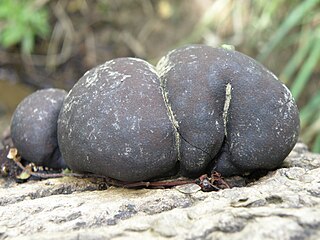
Daldinia is a genus of fungi in the family Hypoxylaceae.
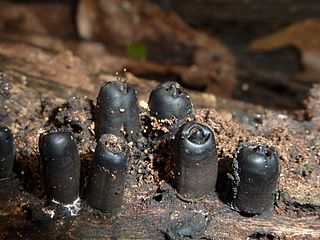
Camillea is a genus of fungi in the family Graphostromataceae. Collectively, the 40+ species in the genus have a widespread distribution, but are especially prevalent in tropical areas. Fruit bodies of Camillea species tend to be cylindrical in shape. The genus was originally circumscribed by Swedish mycologist Elias Fries in his 1849 work Summa vegetabilium Scandinaviae.
Phomatospora is a genus of fungi within the class Sordariomycetes, and since 2016, in the family Phomatosporaceae and order Phomatosporales. They are found in terrestrial, freshwater and marine habitats, across the world except Russia and Canada.
Roussoëlla is a genus of fungi in the family Roussoellaceae. The genus is characterized by two-celled ascospores, unitunicate asci with a small spherical apical ring that stains slightly blue with Melzer's reagent, and stromata with several perithecia. The genus was circumscribed by Italian mycologist Pier Andrea Saccardo in 1888, with Roussoella nitidula assigned as the type species. The generic name honours Marietta Hannon Rousseau, (1850–1926), who was a Belgian mycologist and taxonomist.
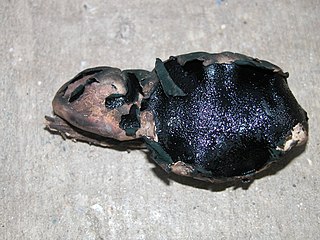
The Boliniaceae are a family of fungi in the Boliniales order. The family consisted of seven genera and 40 species in 2008. A new study found more genera and species in 2020.
Cercophora is a genus of fungi which was within the Lasiosphaeriaceae family. As of 2020, it was placed into the Neoschizotheciaceae family.
Tubeufia is a genus in the Tubeufiaceae family of fungi.
Annulohypoxylon archeri is a saprophytic fungus species. It was moved from the genus Hypoxylon into the genus Annulohypoxylon erected in 2005 by Hsieh, Ju and Rogers.

The Nitschkiaceae are a family of fungi in the Ascomycota, order Coronophorales. Species in the family are mostly saprobic on wood, although some grow on lichens.

Bertia is a genus of fungi within the Bertiaceae family, and Hypocreomycetidae subclass.

The Coniochaeta are a genus of pleomorphic yeasts of the order Coniochaetales and are pathogens of trees. Some species have also been found to form endophytic associations within plants in which they live inside plant tissues but do not actually harm the organism. They can take the form of pink to brown colonies, hyphae, conidiophores or sclerotia. In 2013, the Lecythophora were merged with the Coniochaeta, following suggestions by Ziauddin Khan et al.
Clonostachys is a genus of fungi in the order Hypocreales and family Bionectriaceae.
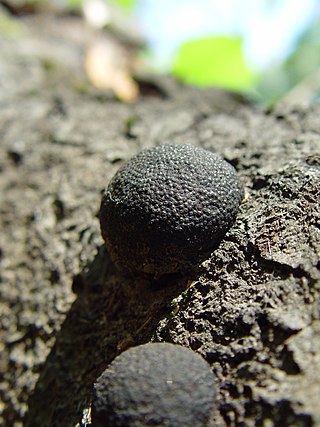
Annulohypoxylon thouarsianum is a species of ascomycete fungus.
Fuscosporellales is an order of fungi within the phylum of Ascomycota and in the class Sordariomycetes and subdivision of Pezizomycotina.

Savoryella is a genus of freshwater and marine based fungi in the family Savoryellaceae and the order Savoryellales.

Pleurothecium is a genus of terrestrial and freshwater fungi in the family Pleurotheciaceae. It is typified by Pleurothecium recurvatum as the type species (Morgan) Höhn, which has the synonym of Carpoligna pleurotheciiF.A. Fernández & Huhndorf, Mycologia 9: 253. 1999.





















